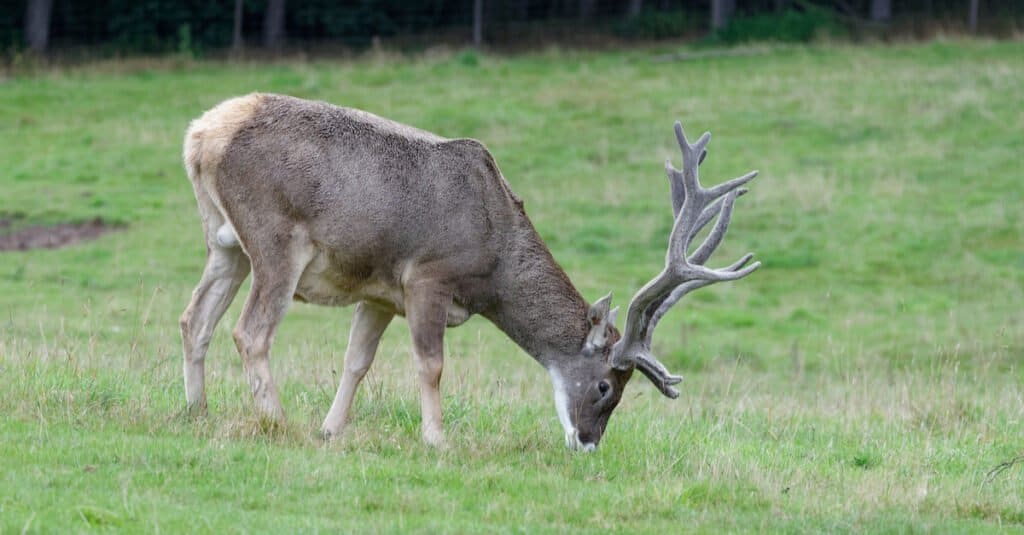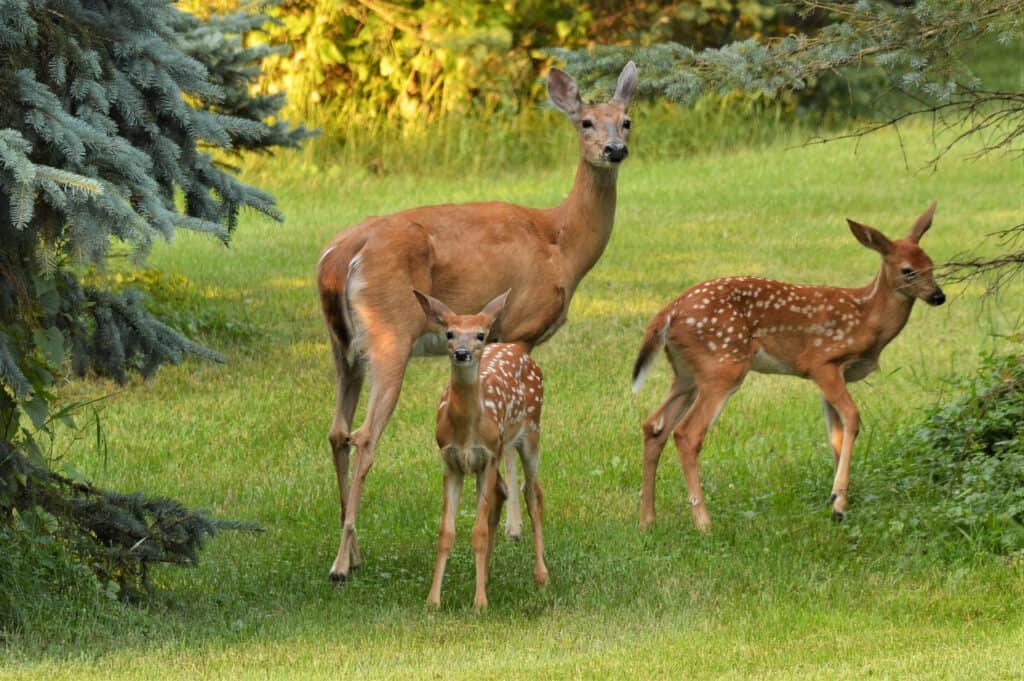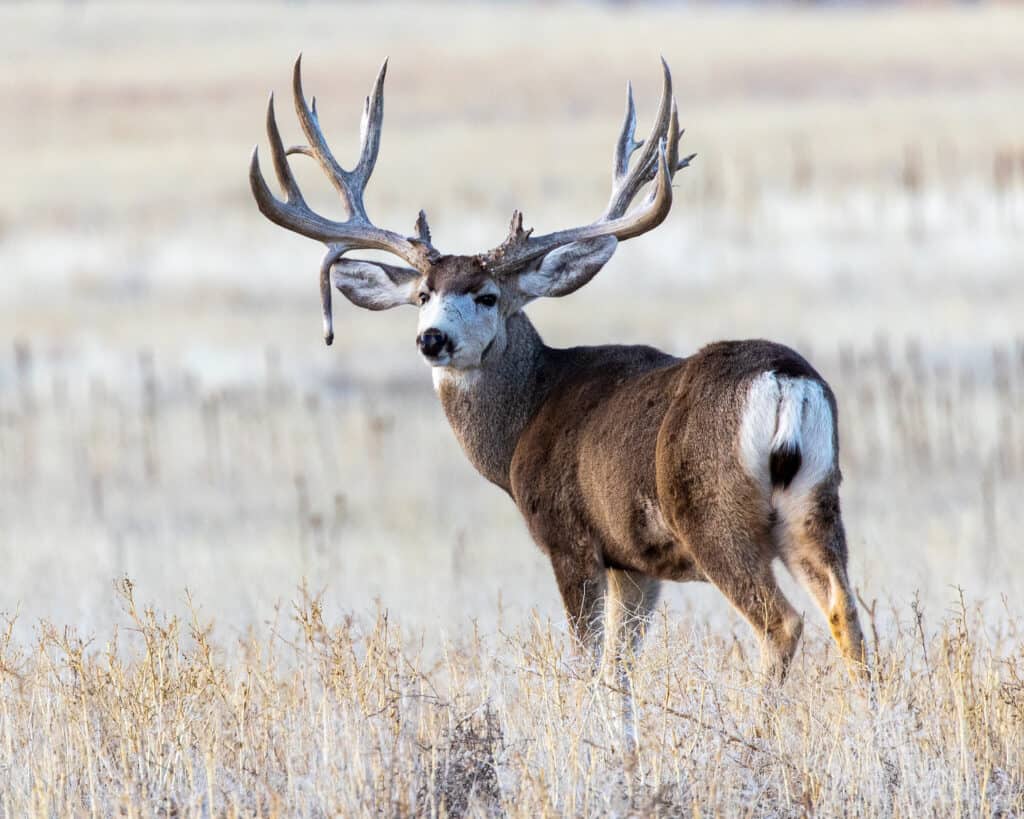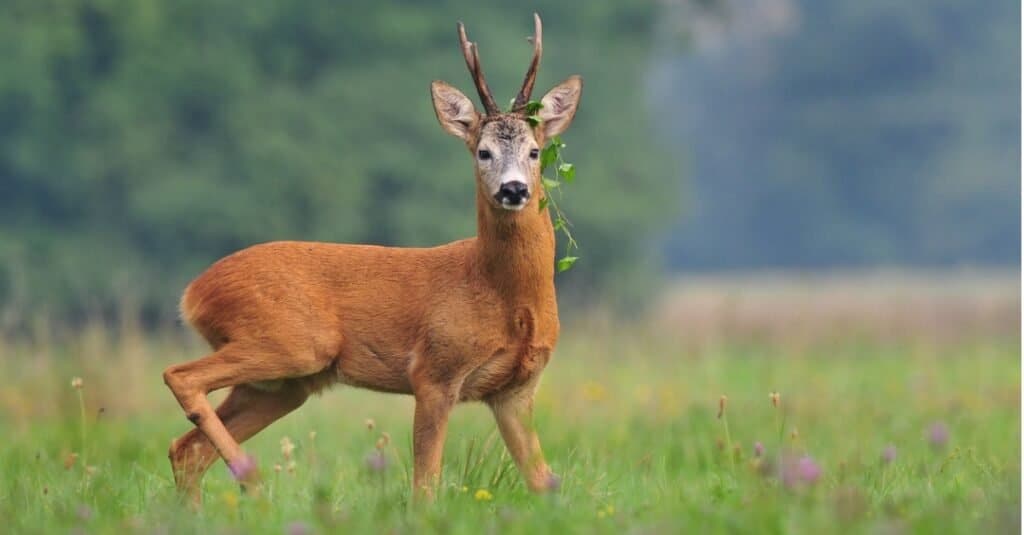Louisiana is divided into ten different areas by the Louisiana Department of Wildlife and Fisheries (LDWF). The dates deer season is open is different depending on these areas, but generally, it is open from as early as mid-September until as late as mid-February. The dates depend on the year since the seasons always start on Saturdays.
Each area has different season types, and each season or area can have different restrictions on the deer that can be harvested. Before hunting, always review the latest hunting regulations from the LDWF for area maps, seasons, licenses required, and the general rules and regulations for deer hunting in the state.
Hunting License Requirements

To hunt a deer in Louisiana, you need a hunting license.
©Martin Fowler/Shutterstock.com
Anyone that wishes to hunt in Louisiana is required to purchase a hunting license. These can be purchased online on the LDWF website, the LDWF headquarters in Baton Rouge, or at many local retailers, usually sporting goods or hunting supply stores.
Anyone that does not live in the state and would like to deer hunt in Louisiana must purchase a non-resident license. A license from any other state is not valid. Louisiana has non-resident licenses that are valid for one year or a lower-cost option valid for five days.
There are also discounted licenses available for youths 17 years of age and younger, senior licenses for hunters 65 years of age and older, and retired military licenses. A combination “Sportsman’s Paradise” license is available for those who like to hunt and fish during various seasons. Disabled individuals also have a special license if they meet specific requirements.
A Lifetime license is available for both residents and non-residents, saving you money if you plan to hunt every year.
Hunter Safety Courses
Anyone born after Sept 1, 1969, is not allowed to hunt in Louisiana without first completing a Hunter Education course that the LDWF approves. There are a few exceptions to this rule. You can hunt without taking the course if you hunt with a person born before Sept 1, 1969, with a valid hunting license, or if that person is 18 years of age or older and has proof that they have completed a hunter education course approved by the LDWF. You must be accompanied by and supervised by this person, which means they are close enough to hear you with a normal voice and be in direct line of sight at all times while hunting.
The Hunter Education course can be taken in person, online with a field day, or 100% online for those 16 years or older.
Permits
To deer hunt in Louisiana, you must also purchase a deer permit. This permit is valid for Archery, Primitive Firearms, and Firearms seasons. It also includes the deer tags to attach to each deer you harvest.
If you would like to hunt in one of the state’s many Wildlife Management Areas (WMA), you must purchase a WMA Access Permit. These permits are available either valid for one year or five days. WMAs offer a unique opportunity to hunt in a managed area owned by the state. Each WMA has specific guidelines, seasons, and limits on the qty and type of deer you can harvest.
Review the Hunting Guide and check with each WMA office before hunting and be aware that the seasons may not be the same as in other areas of the state.
Deer Season Types

The state of Louisiana has five deer season types.
©Lester Graham/Shutterstock.com
Louisiana has five basic deer season types: Archery, Primitive Firearms, Firearms (still-hunt), Firearms (with or without dogs), and Youth/Veterans.
Archery season typically starts in some areas on the third Saturday in September and others on the first Saturday in October. The season continues into January.
Primitive Firearms season is usually open for a week in October or November and again for 5-7 days in January, depending on the area.
There are two different Firearms seasons. The first that opens is still-hunt only; dogs cannot be used during this season. Depending on the area, this season opens in October or November and is open for 2-6 weeks. The second Firearms season is for hunting with or without dogs. This season opens in early December and lasts for about four weeks.
Youths and Honorably Discharged Veterans have their season sometime in the fall and last for one week. Remember that these seasons are open for different amounts of time for each area. Also, each season may allow either sex of deer to be harvested, while others may have specific dates for bucks only.
Season Type Regulations
Each season has specific rules for hunting devices/methods that are allowed. Specifics of these seasons are listed here:
Archery Season
Hunters may use Archery devices during this season, such as traditional bows, compound bows, crossbows, or any bow drawn, held, or released by mechanical means. The minimum draw weight for bows is 30 pounds. No firearms may be used during this season.
Primitive Firearms Season
Primitive Firearms include muzzleloading and single-shot rifles, pistols, and shotguns. Muzzleloaders are firearms that must be loaded exclusively from the muzzle end of the barrel. They must use black powder or an approved substitute powder, and the projectile can only be ball, shot, or bullets.
Rifles and pistols must be .44 caliber or larger, and shotguns must be ten gauge or smaller. Single shot, breech-loading rifles, and pistols must be .35 caliber or larger and have an exposed hammer. They must fire cartridges loaded with either black powder or modern smokeless powder.
Single shot, breech-loading shotguns may be used that are ten gauge or smaller and have an exposed hammer. They can only be loaded with buckshot or slug ammunition. All of these firearms may be fitted with a magnified scope. Other modern firearms are not allowed during this season.
Firearms (Still-Hunt)
Modern Firearms, including rifles, pistols, and shotguns, may be used this season. Rifles and pistols must fire centerfire cartridges that are .22 caliber or larger. Shotguns must be loaded with ammunition that is buckshot or a single slug. The Primitive Firearms listed above may also be used. Dogs may not be used to hunt deer during this season.
Firearms (with or without dogs)
The exact firearm requirements listed in the Firearms Still-hunt season apply to this season. The only difference is that dogs may be used during this season.
Youth and Honorably Discharged Veterans Season
This season is restricted to youths 17 years of age or younger and resident honorably discharged veterans. Archery, primitive, and modern firearms, as described above, are allowed. All youths must have completed a hunter education course.
Youths not completing a hunter education course may hunt but must be accompanied by an adult 18 years or older. The adult must have completed a hunter education course. The adult may accompany up to two youth hunters.
Regulations and Safety Information

Taking a deer while it is swimming is not allowed.
©iStock.com/Jeff Edwards
Below is a list of some critical regulations to keep in mind. This list is certainly not exhaustive; be sure to review the LDWF hunting guide and all the regulations before taking to the field.
- Antlered deer are defined as deer with at least one visible antler of hardened bony material that has broken naturally through the skin. Note that there are no antler length requirements in Louisiana.
- Only one antlered and one antlerless deer may be harvested daily except when a bucks-only season is in progress. Note that some federal lands in Louisiana only allow one deer per day.
- The season limit is six deer, not to exceed three antlered or four antlerless deer. There are some exceptions to this in certain areas.
- Anyone hunting wildlife during the open firearms deer season and possessing buckshot, slugs, a primitive firearm, or a centerfire firearm must wear a “Hunter Orange” or “Blaze Pink” garment. The garment must be worn on your head, chest, and back and be no less than 400 square inches.
- Taking a deer while it is swimming is not allowed. Taking a deer from a boat with a motor attached and in an operating position is not allowed.
- Pursuing, driving, or hunting deer with dogs or moving vehicles during a still hunting season or area is not allowed. Training dogs during a still hunting season is also not allowed.
- Hunting hours are restricted to 30 minutes before sunrise until 30 minutes after sunset.
- Hunting or shooting deer on a public road or right-of-way is not allowed.
- Spotlighting or shining lights from public roads searching for deer is not allowed.
Safety Guidelines
Anytime firearms are involved, safety should be a priority.
Always treat your weapon with respect. Most importantly, be sure of your target and what is beyond your target. Make sure you’re taking a proper deer for the season you are hunting and that nothing beyond your target deer could be at risk if you miss. You are responsible for every bullet or arrow that leaves your weapon. Taking two deer in one day could be illegal.
It is common to believe that most hunting accidents are from firearms. Falls from tree stands are the most common hunting accident. 35% of falls are from equipment failure; always inspect your tree stand before heading out to hunt. 85% of fall victims do not wear a safety harness.
Always wear a safety harness to catch you if you lose your balance. 99% of fall victims did not connect their safety harness correctly. Know your equipment and connect it before your feet leave the ground.
Chronic Wasting Disease Concerns in Louisiana

In 2022, Louisiana became the 29th state to detect CWD in the wild population.
©Soru Epotok/Shutterstock.com
Chronic Wasting Disease (CWD) is a neurodegenerative disease found in most deer species, including white-tailed deer, mule deer, elk, and moose. CWD was detected in Louisiana in 2022, and it became the 29th state in the United States to detect CWD in the wild population. This disease is contagious, invariably fatal, and causes irreversible brain tissue damage, leading to deer losing weight over time, excessive salivation, and confusion.
CWD can spread through direct deer-to-deer contact or through contact with urine and feces, saliva, and body parts that are infected. The prions, the mutated proteins that cause CWD, can bind to soil particles once an infected deer have decomposed and will remain in a location for years.
Importing any carcass that is in the cervid family into Louisiana is restricted. Also, whole carcasses from areas east of the Mississippi River in East Carroll, Madison, Tensas, and Concordia parishes may not be transported to other areas of Louisiana. The carcass must be processed or taxidermy completed before bringing into the state or these other areas.
The meat must be boned out, cut, and wrapped. The spinal column or head of the carcass must not be transported away from the harvest area (only finished taxidermy mounts are allowed). Antlers, clean skull plates, hides, and cleaned teeth are allowed.
Safe Handling of CWD-Infected Deer
The Centers for Disease Control says there is no evidence that CWD can infect humans. However, the CDC recommends caution when handling deer in an infected region and that deer be tested for CWD before consumption.
Be sure to wear gloves when field-dressing and processing the deer, and thoroughly wash the area and all your instruments. Minimize the handling of the brain and spinal cord. Any deer that is CWD-positive should not be consumed.
If you harvest an adult buck deer, you can contact your local LDWF office to arrange to test. Anyone who submits a deer for testing with a 10-inch or larger inside antler spread and provides the GPS coordinates of the harvest site will be entered to win a $1000 gift card. This is valid for the current 2022-2023 white-tailed deer season.
If you see a deer while hunting that may have the symptoms of CWD, note the location and report it to the LDWF.
What to do After a Deer is Harvested?
Before hunting deer, make sure you have either paper deer tags with your deer permit or electronic versions on your mobile device. Immediately after harvesting a deer, tag the deer with the paper tag or fill out the electronic tag. Make sure you indicate the date and area of the kill.
You can then field dress and transport the deer away from the harvest site. The tag must remain attached to the deer until you get back to your home or drop it off at a deer processor or taxidermist. Within 72 hours of the harvest, you must validate the harvest with the LDWF. This can be done using text-to-tag, the LDWF website, or by phone.
Fines for Not Following Regulations
Harvesting deer illegally in Louisiana can result in fines, loss of hunting privileges, and even jail time. Lawyer fees and court costs are also high if your case goes to court, even if you are acquitted.
For example, in 2019, a man was found to have taken two bucks in one day in an area where only one buck per day was allowed. He checked in one buck on the day he harvested it and returned the next day to tag and transport the other buck. He will face up to $1800 in fines, jail for up to 230 days, and loss of hunting privileges.
Before you hunt, be sure you review and understand all of the hunting regulations, seasons, areas, and limits.
Up Next
- Discover the Deadliest Animals in Louisiana
- Wildlife in Louisiana
- Deer Facts
- Deer Season In Hawaii: Everything You Need To Know To Be Prepared
The photo featured at the top of this post is © iStock.com/tmphoto98
Sources
- Louisiana Department of Wildlife and Fisheries, Available here: https://www.wlf.louisiana.gov/page/seasons-and-regulations
Thank you for reading! Have some feedback for us? Contact the AZ Animals editorial team.






